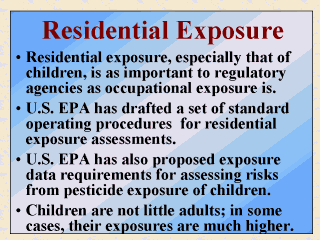| front |1 |2 |3 |4 |5 |6 |7 |8 |9 |10 |11 |12 |13 |14 |15 |16 |17 |18 |19 |20 |21 |22 |23 |24 |review |
 |
In the last few
slides, much discussion was given on occupational exposure. There is also a great deal of
regulatory interest placed in residential exposure, especially in that of children. To
this end, U.S. EPA has drafted a set of standard operating procedures (SOP) for
residential exposure assessments (1997c) and proposed exposure data requirements for
assessing risks from pesticide exposure of children (1999a). The objective of the SOP is to provide standard methods for developing non-dietary residential exposure assessments for both applicators (users) and post-application exposures when chemical- or site-specific field data are limited. The SOP cover calculation algorithms for estimating dermal, inhalation, and/or incidental ingestion doses for a total of 13 major residential exposure scenarios: (a) lawns; (b) garden plants; (c) trees; (d) swimming pools; (e) painting with preservatives; (f) fogging; (g) crack and crevice treatments; (h) pet treatments; (i) detergent; (j) impregnated materials; (k) termiticides; (l) inhalation of residues from indoor treatments; and (m) rodenticides. Children are not little adults. In many cases, their exposures to environmental contaminants can be much higher than those of non-user adult residents. As the above guidance on data requirements puts it, children will crawl, roll, and climb over contaminated surfaces while having a smaller body surface-to-body weight ratio than adults. They eat different foods which may result in higher dietary ingestion. Their hand- and object-to-mouth activities will also result in nondietary ingestion if the hands or objects (e.g., toys) are contaminated. |